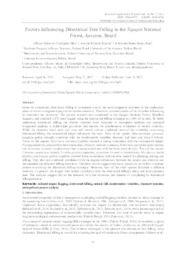Factors influencing directional tree felling in the Tapajós National Forest, Amazon, Brazil.
Factors influencing directional tree felling in the Tapajós National Forest, Amazon, Brazil.
Author(s): SILVA, U. S. da C.; RUSCHEL, A. R.; REIS, I. M. S.
Summary: Given its complexity, directional felling is considered one of the most dangerous activities in the exploratory phase of forest management projects for timber obtention. Therefore, detailed studies of the variables influencing its execution are necessary. The present research was conducted in the Tapajós National Forest, Brazilian Amazon, and analyzed 1,075 trees logged using the directional felling technique in a 504.30 ha area. To better understand directional felling, the studied variables were subjected to descriptive analyses and principal component analysis, a multivariate procedure that enables the simultaneous evaluation of several variables. While the diameter, basal area, and stem and branch volume explained most of the variability concerning directional felling, the commercial height influenced the least. Trees of the species Hymenolobium petraeum (angelim pedra) strongly correlated with the dendrometric variables diameter and stem and branch volume. Those of the species Hymenaea courbaril (jatobá) showed a strong correlation with the commercial height. Pseudopiptadenia psilostachya (fava timborana), Dipteryx odorata (cumaru), Hymenaea parvifolia (jutai mirim), and Astronium lecointei (muiracatiara) had a strong correlation with the basic wood density. Trees of the species Couratari guianensis (tauari), Lecythis pisonis (sapucaia), Astronium lecointei (muiracatiara), Mezilaurus itauba (itaúba), and Goupia glabra (cupiúba) showed lower correlations with the time needed for planning, cutting, and felling. They also had a reduced correlation with the angular differences between the natural and effective and the intended and effective felling directions. The latter results suggest that these species do not follow a defined pattern concerning the directional felling technique. However, trees of the other species followed a different tendency. In general, the logged trees lacked correlation with the directional felling cutting and total operation time. The analyses suggest that as the diameter of a tree increases, the chances of completing its directional felling decrease.
Publication year: 2022
Types of publication: Journal article
Unit: Embrapa Eastern Amazon
Observation
Some of Embrapa's publications are published as ePub files. To read them, use or download one of the following free software options to your computer or mobile device. Android: Google Play Books; IOS: iBooks; Windows and Linux: Calibre.
Access other publications
Access the Agricultural Research Database (BDPA) to consult Embrapa's full library collection and records.
Visit Embrapa Bookstore to purchase books and other publications sold by Embrapa.

